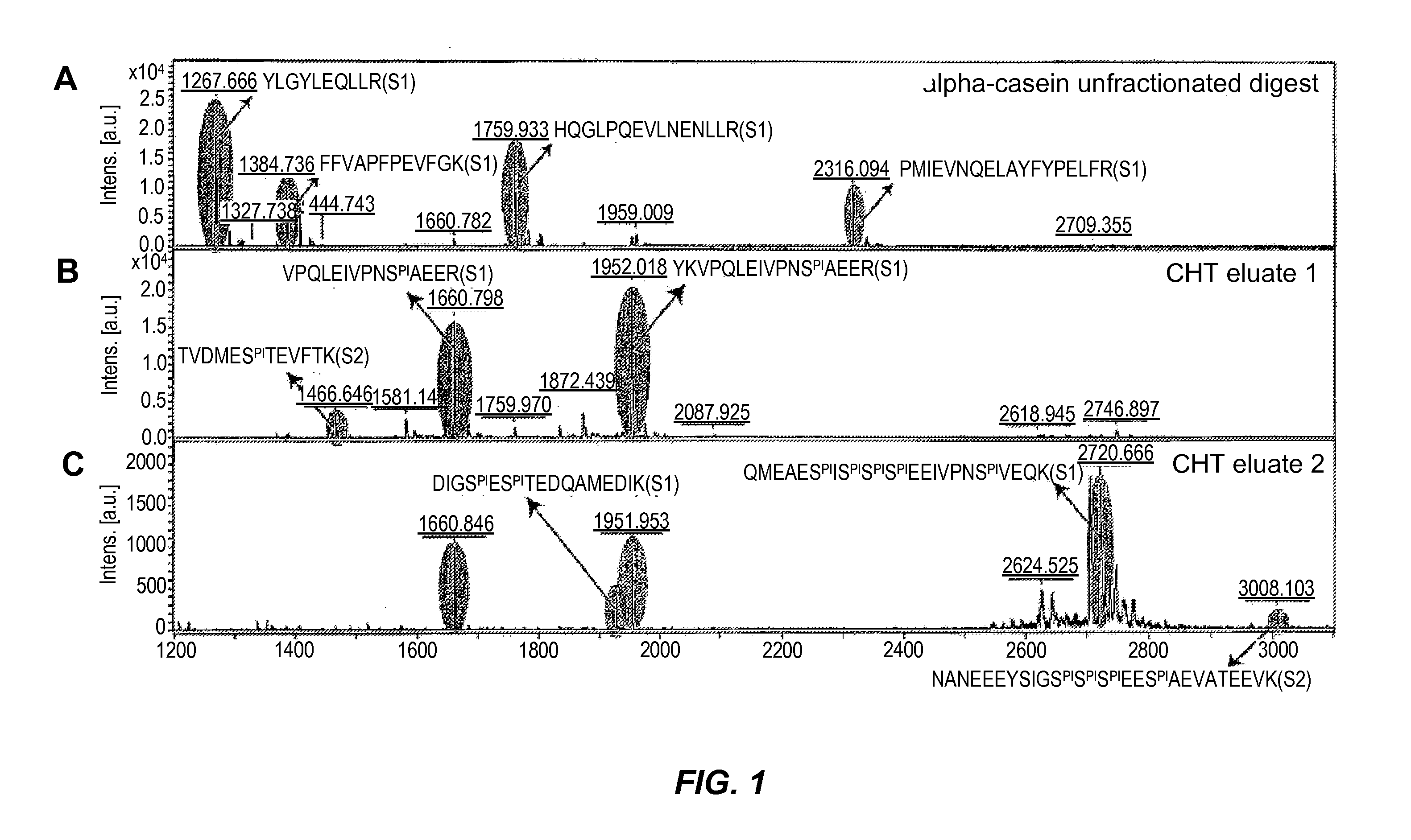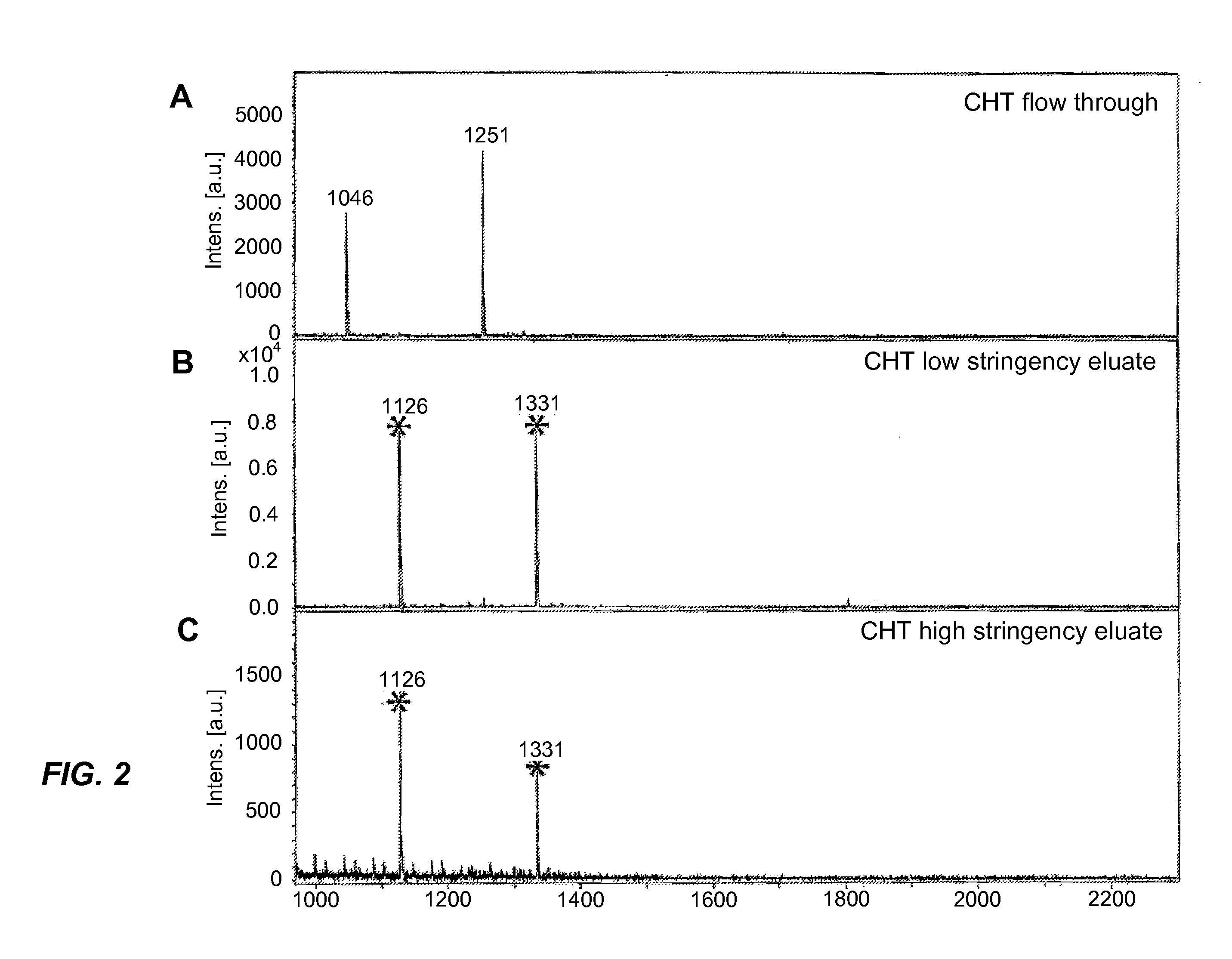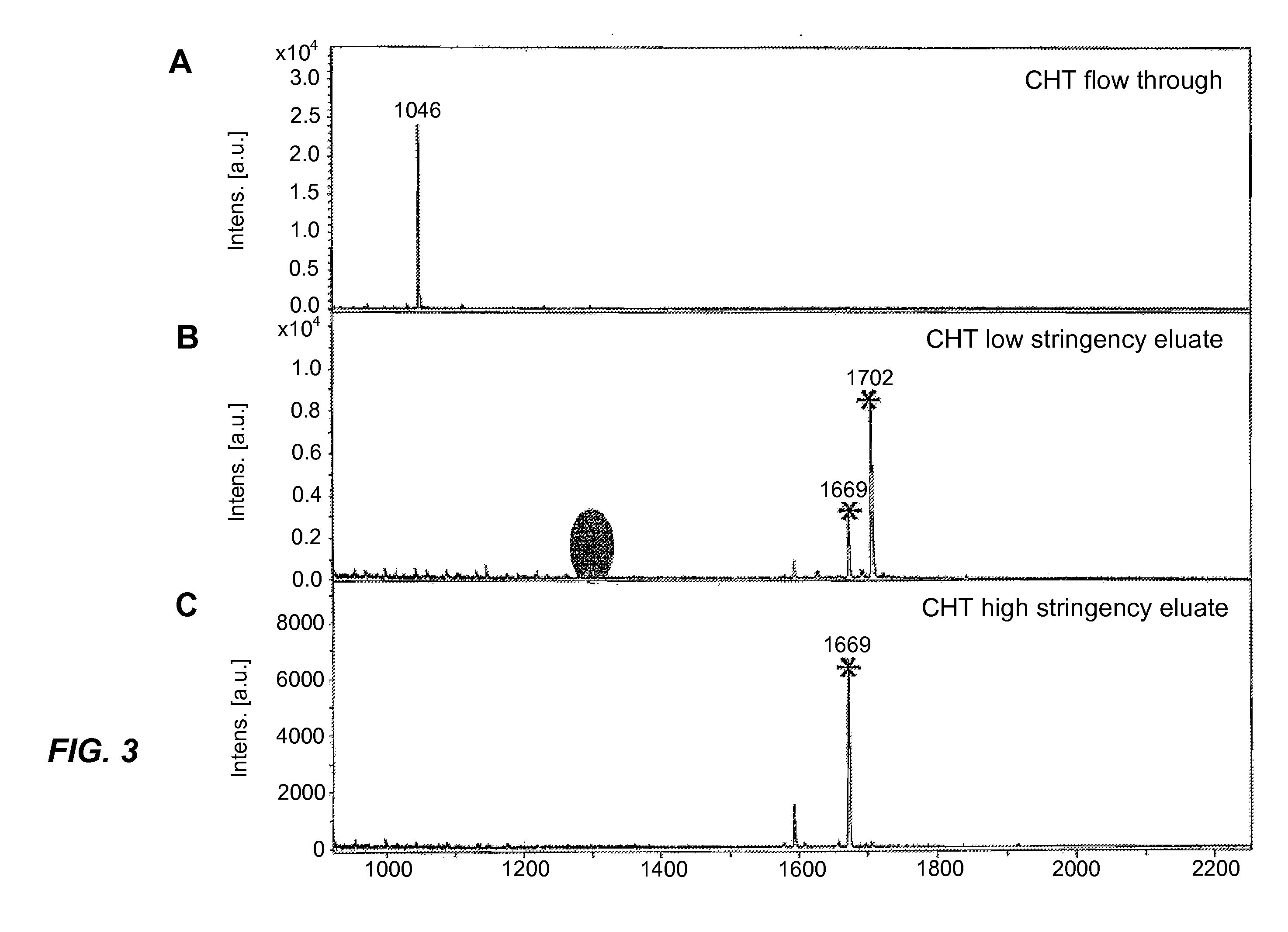Phosphopeptide enrichment of compositions by fractionation on ceramic hydroxyapatite
a technology of ceramic hydroxyapatite and enrichment, which is applied in the field of phosphorylated peptides and the fractionation of peptides, can solve the problems of lowering the possibility of non-specific protein or peptide binding, lack of additional support, etc., and achieves high throughput enrichment, high pressure, and reduced the effect of binding
- Summary
- Abstract
- Description
- Claims
- Application Information
AI Technical Summary
Benefits of technology
Problems solved by technology
Method used
Image
Examples
example 1
[0023]Ceramic hydroxyapatite Type I, 20 microns in particle size, was used with the following buffer solutions in which all percents are by weight:
Binding Buffer40 mM Tris, pH 925 mM NaH2PO4(no Urea, Thiourea, or CHAPS)Low Stringency Elution40 mM Tris, pH 9Buffer25 mM NaH2PO4500 mM NaCl(no Urea, Thiourea, or CHAPS)High Stringency Elution500 mM NaH2PO4, pH 7.5Buffer(no Urea, Thiourea, or CHAPS)*CHAPS: 3-[(3-cholamidopropyl)dimethylammonio]-1-propanesulfonic acid
[0024]Micro Bio-Spin columns of Bio-Rad Laboratories, Inc. (Catalog No. 732-6204) were packed with 40 mg to 200 mg of Ceramic Hydroxyapatite (CHT) Type I, 20 micron diameter beads (Bio-Rad Laboratories, Inc.) over a ten-micron frit. Binding buffer (500 μL) was added to each column, and the buffer and meads were mixed and incubated in the column for two minutes. The columns were then spun at 5,000×g for thirty seconds, and the flow-through buffer was discarded. The sample was then prepared in the binding buffer, and a quantity ...
example 2
[0030]The sample used in this example was a Protea peptide standard PS-181 (Protea Biosciences, Inc., Morgantown, W.V., USA). This standard consisted of three peptides (M / Z 1046, 1251, 1722) and their singly-phosphorylated forms (M / Z 1125(pY), 1331(pS), 1802(pT)). The mixture was applied to the CHT beads using 50% acetonitrile and 0.5 mM Tris as the binding buffer. Elution was then performed, using a buffer containing 1 mM Tris and 25 mM methylphosphonate, pH 8.5 as the low-stringency buffer and a buffer containing 500 mM sodium phosphate, pH 9.0 as the high-stringency buffer. The results are shown in FIG. 2 of which Part A is the spectrum of the flow-through fraction, Part B is the spectrum of the low-stringency eluate, and Part C is the spectrum of the high-stringency eluate. The spectra show that the non-phosphorylated peptides 1046 and 1251 were in the flow-through fraction, and the phosphopeptides 1126(pY) and 1331(pS) were in both eluates. This indicates a clear separation of ...
example 3
[0031]The sample used in this example was an Invitrogen peptide standard P33357 (Invitrogen Corporation, Carlsbad, Calif., USA) consisting of three peptides (MIZ 1046, 1296, 1578) and four phosphopeptides with phosphorylation on different amino acid residues (M / / Z 1669(pTpY), 1702(pY), 1720(pT), and 2192(pS)). The mixture was applied to the CHT beads using 50% acetonitrile and 0.5 mM Tris as the binding buffer. Elution was then performed, using a buffer containing 1 mM Tris and 25 mM methylphosphonate, pH 8.5 as the low-stringency buffer and a buffer containing 500 mM sodium phosphate, pH 9.0 as the high-stringency buffer. The results are shown in FIG. 3 of which Part A is the spectrum of the flow-through fraction, Part B is the spectrum of the low-stringency eluate, and Part C is the spectrum of the high-stringency eluate. The spectra show that the non-phosphorylated peptide 1046 was detected only in the flow-through fraction and the phosphopeptides 1669(pTpY) and 1702(pY) were det...
PUM
| Property | Measurement | Unit |
|---|---|---|
| diameters | aaaaa | aaaaa |
| diameters | aaaaa | aaaaa |
| diameters | aaaaa | aaaaa |
Abstract
Description
Claims
Application Information
 Login to View More
Login to View More - R&D
- Intellectual Property
- Life Sciences
- Materials
- Tech Scout
- Unparalleled Data Quality
- Higher Quality Content
- 60% Fewer Hallucinations
Browse by: Latest US Patents, China's latest patents, Technical Efficacy Thesaurus, Application Domain, Technology Topic, Popular Technical Reports.
© 2025 PatSnap. All rights reserved.Legal|Privacy policy|Modern Slavery Act Transparency Statement|Sitemap|About US| Contact US: help@patsnap.com



